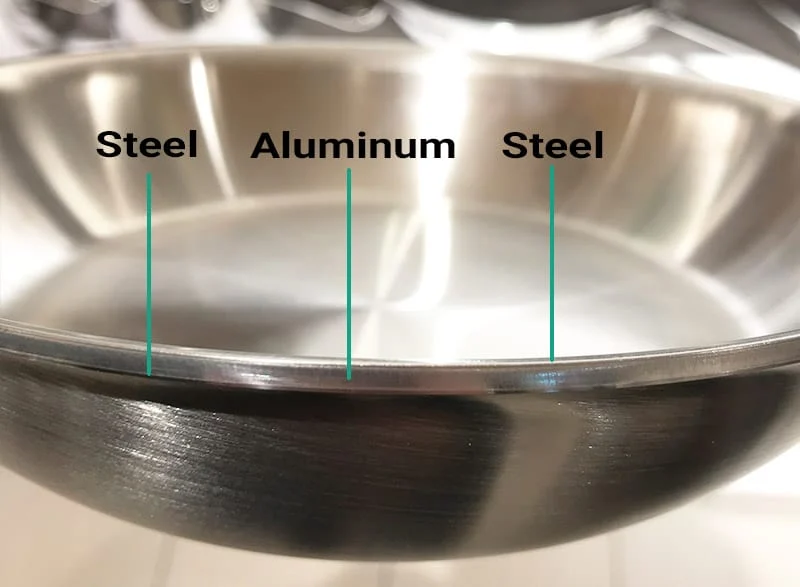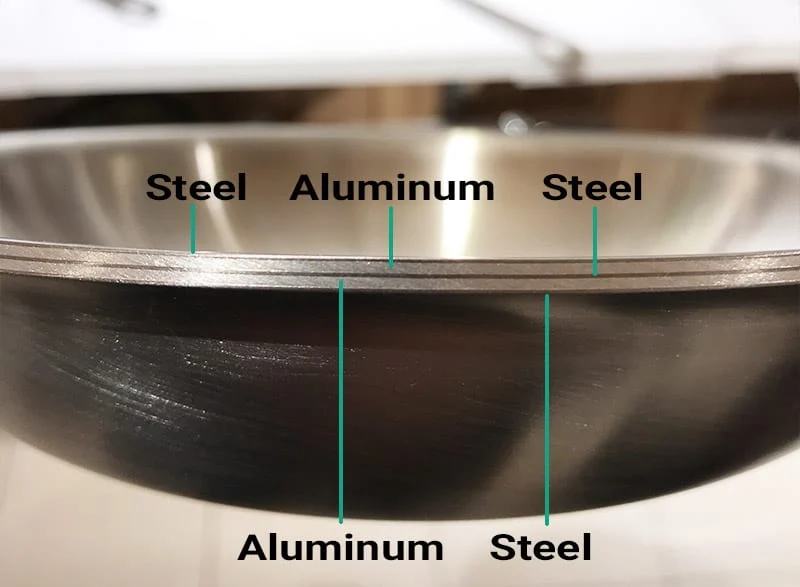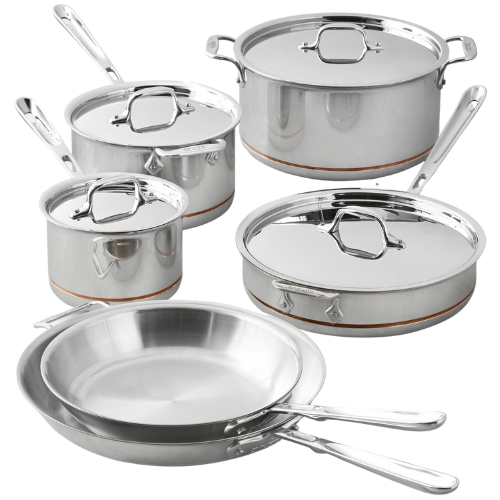All-Clad D5 vs D3: Which One Should You Buy?
All-Clad D3 vs. D5: It might seem like a tough choice, but there are clear differences between the lines. If you understand how they’re different, it’s easy to know which line is best for you and make the right choice.
All-Clad D3 vs. D5: Key Differences
The D3 uses a tri-ply construction, while the D5 features a 5-layer design.
All-Clad’s D3 features a tri-ply construction, meaning it has three layers: an aluminum core sandwiched between two layers of stainless steel.

The D5 line features a five-ply construction, meaning it has two layers of aluminum, two layers of stainless steel, and a stainless steel core.

Thanks to the addition of a stainless steel core, the D5 gains extra structural strength. Meanwhile, the D3 is lighter in weight, making it easier to handle and ideal for everyday cooking.
All-Clad D3 vs. D5: Cooking Performance
The D3 conducts heat more efficiently
With D3 cookware, the single aluminum core layer heats up quickly and transfers that heat evenly to the steel cooking surface. When you turn on the burner, you can expect your pan to be ready for action within a couple of minutes.
D5 cookware heats slower because the steel core defuses heat. Steel has a much lower thermal conductivity than aluminum; therefore, it slows the heat transfer from the burner to the cooking surface. Heating slower sounds like a downside, but D5’s unique construction has both positive and negative effects on cooking performance.
Positive impacts of the additional layers in D5 cookware
D5 provides slightly more even heating and higher tolerance for temperature fluctuations.
Even Heating: The extra core layer of steel creates a barrier that slows heat transfer to the cooking surface. This ensures that heat is spread evenly across the entire pan by the time it’s ready to go.
Forgiving: Since D5 cookware heats up and cools down slower than D3, you’re less likely to overcook or burn your food when you accidentally turn the temperature too high. This doesn’t mean that you can’t burn food with D5 cookware; it just means that you have a little more leeway.
The D5 is better suited for induction cooktops, whereas the D3 performs best on gas stoves.
The chief technical difference between D5 and D3 is the weight. A heavier pan will hold more heat, everything else being equal. But it will do so at the cost of greater thermal inertia. That is, it will be less responsive.
Greater weight and higher thermal inertia are good properties for cooking on induction stoves or electric flattops because such ranges toggle the heat souce on and off to moderate temperatures. For high output gas ranges, where the heat source is continuous, lighter can be better because the vessels are more quickly responsive.
Therefore the heavier D5 works well with induction, while the lighter D3 shines on gas burners.
Other Improvements of D5
✅ D5 Added thumb rest indentation on handles for better grip stability.
✅ Full flared rims on all pans of D5 to make for easier, drip-free pouring (unlike D3, where some models lack this feature).
✅ D5 has brushed finish (less-polished stainless steel on the outside, giving it a less shiny and more matte appearance that hides scratches better).
All-Clad D3 vs. D5: Which One Should You Buy?
For the vast majority of people, we recommend the All-Clad D3 Stainless line. Our tests consistently prove it delivers the best value for its performance, price, and durability.
While the D3 and D5 each have strengths, these differences won’t meaningfully impact your cooking unless you’re exceptionally particular. In real-world use, you’ll likely never notice them. However, the D3’s lower price (around 30% cheaper than the D5) makes it the smarter investment. (Check Price of All-Clad D3 on Amazon >>)
Here’s What We Recommend of All-Clad D3→ Check Real User Reviews on Amazon
If your budget is flexible and you want nothing but the best fit for your needs, here’s my honest advice:
Here’s What We Recommend of All-Clad D5→ Check Real User Reviews on Amazon
FAQ
What Makes All-Clad So Expensive (And Is it Worth the Price)?
Clad stainless cookware is more expensive to make than other types of cookware, so that increases the cost. All-Clad clad stainless steel cookware is made in the USA, which also raises the price. The All-Clad brand adds to the cost, too. But most of all, All-Clad is high quality cookware, and high quality products have a higher cost. But because All-Clad will last for decades and comes with a lifetime warranty against manufacturing defects, your cost-per-year-of-use will be low, so it is well worth the initial investment.
Are D3 and D5 Both Dishwasher Safe?
Yes, technically both D3 and D5 are dishwasher safe, but your cookware will retain its shiny surface if you wash by hand. Since you can soak steel and use abrasive cleansers and pads to clean, it’s not hard to clean. No, it’s not as easy as nonstick, but its durability, safety, and longevity are worth the extra elbow grease you may occasionally need to clean your clad stainless pans.
Does All-Clad cookware have a good warranty?
All-Clad’s stainless steel products—including pots, pans, skillets, and cookware sets—are backed by a lifetime warranty.
Can All-Clad cookware go in the oven?
All-Clad stainless steel cookware is oven-safe up to 600°F. Be aware that extended exposure to heat above 500°F may result in discoloration, but pan performance won’t be affected.

